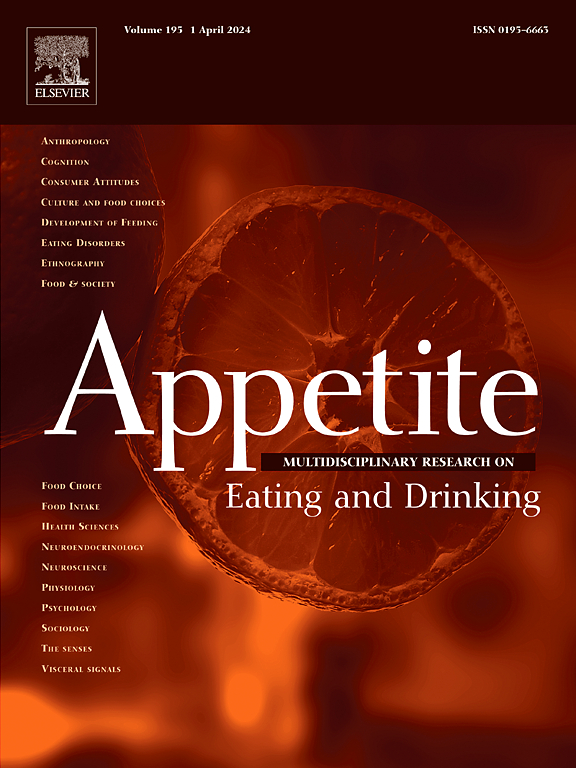Validating the children's eating behaviour questionnaire in a UK sample: A suitable tool for mothers and fathers
IF 3.8
2区 医学
Q1 BEHAVIORAL SCIENCES
引用次数: 0
Abstract
Children's eating behaviour is a complex construct linked to various health, social, and psychological outcomes. The Children's Eating Behaviour Questionnaire (CEBQ)assesses parents' perceptions of children's eating behaviours across eight subscales: food fussiness, enjoyment of food, food responsiveness, satiety responsiveness, desire to drink, slowness in eating, and emotional under- and overeating. Given that the initial validation of the CEBQ dates back to the early 2000s, this study aimed to (1) evaluate the psychometric properties of the CEBQ in a UK sample using current psychometric recommendations and (2) examine its measurement invariance based on parental sex. A total of 994 caregivers (196 fathers and 798 mothers) of children aged 3–5 years completed the questionnaire. The performance of the scale revealed that 23 items exhibited ceiling or floor effects or failed to meet recommended item-total correlation coefficients. Exploratory factor analysis supported an eight-factor, 34-item structure, which was confirmed via confirmatory factor analysis: X2 = 2129.845 (df = 499; p < 0.001), TLI = 0.911, CFI = 0.921, RMSEA = 0.083 (90 % CI 0.079–0.087) and SRMR = 0.080. All factors demonstrated adequate internal consistency (omega 3 values over 0.7). Measurement invariance testing confirmed strict invariance by parental sex, indicating the instrument performs equivalently for mothers and fathers. These findings support the use of the revised 34-item CEBQ with its eight original factors for both maternal and paternal respondents. However, future research should consider revising certain CEBQ items included to strengthen its capacity to capture variations in children's eating behaviour, and to provide a more accurate evaluation of the construct.
验证儿童饮食行为问卷在英国的样本:一个适合的工具,为母亲和父亲。
儿童的饮食行为是一个复杂的结构,与各种健康、社会和心理结果有关。儿童饮食行为问卷(CEBQ)通过8个分量表评估家长对儿童饮食行为的看法:食物挑剔、食物享受、食物反应、饱腹反应、饮水欲望、进食缓慢、情绪性饮食不足和暴饮暴食。鉴于CEBQ的最初验证可以追溯到21世纪初,本研究旨在(1)使用当前的心理测量建议评估CEBQ在英国样本中的心理测量特性,(2)检查其基于父母性别的测量不变性。共有994名3 ~ 5岁儿童的照顾者(196名父亲和798名母亲)完成了问卷调查。量表的表现显示,23个项目表现出天花板或地板效应或未能满足建议的项目总量相关系数。探索性因子分析支持8因子34项结构,经验证性因子分析证实:X2=2129.845 (df=499
本文章由计算机程序翻译,如有差异,请以英文原文为准。
求助全文
约1分钟内获得全文
求助全文
来源期刊

Appetite
医学-行为科学
CiteScore
9.10
自引率
11.10%
发文量
566
审稿时长
13.4 weeks
期刊介绍:
Appetite is an international research journal specializing in cultural, social, psychological, sensory and physiological influences on the selection and intake of foods and drinks. It covers normal and disordered eating and drinking and welcomes studies of both human and non-human animal behaviour toward food. Appetite publishes research reports, reviews and commentaries. Thematic special issues appear regularly. From time to time the journal carries abstracts from professional meetings. Submissions to Appetite are expected to be based primarily on observations directly related to the selection and intake of foods and drinks; papers that are primarily focused on topics such as nutrition or obesity will not be considered unless they specifically make a novel scientific contribution to the understanding of appetite in line with the journal's aims and scope.
 求助内容:
求助内容: 应助结果提醒方式:
应助结果提醒方式:


